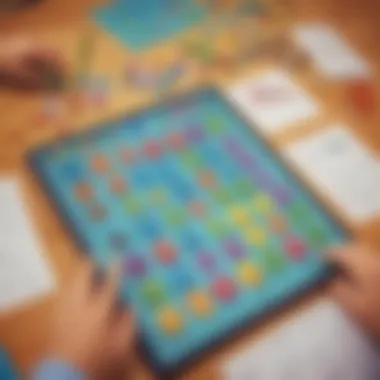Effective Strategies to Boost Your Math Skills


Intro
Mathematics often gets a bad rap among students and parents alike, perceived as a daunting subject marked by abstract concepts and rigid formulas. Yet, it doesn't have to be that way. Fostering a solid foundation in math skills is not just essential for academic success, but it can also cultivate critical thinking and problem-solving abilities that extend far beyond the classroom. In this narrative, we will delve into various strategies aimed at enhancing math skills, particularly focusing on elementary school learners. By navigating through creative activities, engaging quizzes, and informative articles, we can uncover a treasure trove of methodologies that inspire curiosity and promote mastery in mathematics.
Creative Activities
Engagement in creative activities can spark a child’s interest in math while making learning enjoyable. Here are some enriching ideas:
Craft Ideas
- Math Art Collage: Combine art with math by helping kids create a collage using shapes. Gather different materials like colored paper, scissors, and glue. Ask them to cut various geometric shapes and create a vibrant math-oriented design. This not only reinforces shape recognition but also adds a fun twist to the learning process.
- Counting Bugs: Use plastic bugs or draw them on paper, distributing them into various containers. Children can categorize and count them by color, type, or size. This hands-on approach fosters counting skills and reinforces the concept of classification.
Step-by-Step Guides
To successfully implement these activities:
- Gather all necessary materials beforehand.
- Provide clear instructions, demonstrating the process step by step.
- Encourage children to express their creativity within the framework of math principles.
Educational Value
The beauty of engaging in these creative crafts lies in their dual purpose. They serve as a medium of artistic expression and a practical tool for reinforcing mathematical concepts. As kids are involved in hands-on activities, they begin to associate math with fun, which can significantly alter their attitude toward the subject.
Fun Quizzes
Incorporating quizzes in a child’s learning process can boost retention and understanding of math topics. On platforms like ElemFun, various types of quizzes are available that make learning interactive.
Quiz Topics
Popular subjects include addition and subtraction, multiplication basics, fractions, and geometry. Each topic can contain multiple quizzes to ensure diverse learning experiences.
Question Types
The variety of question types helps maintain engagement and can range from multiple choice to fill-in-the-blank, or even puzzles that require critical thinking. This keeps students on their toes and encourages a more robust understanding of difficult concepts.
Knowledge Reinforcement
Quizzes serve not only as an assessment tool but as a means to consolidate knowledge. Regular practice through quizzes strengthens memory and enhances problem-solving skills, making it less likely for students to forget what they've learned.
Fact-Based Articles
Fact-based articles offer another layer of learning that can be deeply enriching. These pieces of content often break down complex topics into digestible segments for young learners.
Topics
Such articles can cover a broad array of subjects, from the history of numbers to the importance of math in daily life. This diversity keeps students informed and curious about the world around them.
Engaging Content
Writers of these articles should employ a simple yet engaging style that captures children's attention. Using visuals, relatable examples, and straightforward language makes information more accessible.
Understanding the Fundamentals of Mathematics
Mathematics forms the backbone of countless daily tasks, workplaces, and academic pursuits. Its foundations are essential to grasping the complexities of the subject, especially for those in elementary education. Without solid grounding in basic concepts, learners may struggle as they advance to more challenging material. Thus, understanding mathematics fundamentals isn’t merely a stepping stone; it’s the very bedrock upon which future learning is built.
Learning the fundamentals empowers students in ways that extend beyond the classroom. It teaches critical thinking, logical reasoning, and problem-solving skills that are invaluable in real life. By mastering basic principles, learners gain the confidence to tackle a variety of mathematical challenges as they arise, thus nurturing a resilient mindset that will serve them throughout their lives.
The Role of Numeracy in Daily Life
Numeracy is often defined as the ability to understand and work with numbers. It enables individuals to make sense of quantitative information encountered daily. From calculating expenses during a shopping trip to understanding the timing of public transportation, numeracy is an integral part of navigating the modern world.
Numerous everyday situations highlight the importance of numeracy. For instance, when cooking, measuring ingredients requires precise calculations. When budgeting, simple arithmetic helps manage income and expenditures effectively. This practicality often leads to the realization that math isn’t just a subject confined to school; it’s a pervasive skill woven into the very fabric of life.
"Math is the language of the universe; where numbers narrate stories about the world around us."
Conceptual vs. Procedural Knowledge


In mathematics, knowledge can be broadly categorized into two types: conceptual and procedural. Understanding the difference between these two aspects is crucial for developing strong mathematical skills.
Conceptual knowledge refers to comprehension of mathematical concepts and their relationships. This type of understanding enables learners to make connections across different areas of math. For example, comprehending why the order of operations matters lays the groundwork for more complex problems down the line.
On the other hand, procedural knowledge focuses on the methods and processes involved in solving mathematical problems. This includes the various techniques and algorithms used for calculations. While it’s important to know how to apply a procedure, mere rote memorization may lead to a lack of deeper understanding.
Balancing both forms of knowledge is essential. Relying solely on procedural skills may bring about short-term success, but without a solid conceptual base, students might find themselves lost in more advanced topics. By encouraging learners to explore and understand the "why" behind mathematical processes, educators can foster a more meaningful connection with the subject.
In summary, grasping the fundamentals of mathematics is not only about understanding numbers but also about appreciating their significance in everyday life and nurturing a holistic approach to learning. This solid foundation enriches learners and prepares them for the broader mathematical challenges that lie ahead.
Recognizing Common Mathematical Challenges
Recognizing common mathematical challenges is essential for understanding the hurdles many learners face. It’s not just about numbers and equations; it’s also about emotions and misconceptions that can derail progress. Recognizing these challenges helps educators and parents tailor their strategies and interventions effectively to enable better learning outcomes. By addressing the psychological and cognitive barriers, it opens the door to a more profound engagement with mathematical concepts.
Anxiety and Performance Pressure
Anxiety is a common adversary in academic settings, particularly in mathematics. When a student enters an exam room, the weight of expectations can be tremendous. This pressure can manifest physically and mentally, causing issues like tightness in the chest, racing thoughts, or even blanking out when the paper is in front of them. Here’s what makes addressing math anxiety so important:
- Recognizing Triggers: Understanding what triggers anxiety is the first step. It might be the fear of failing, the pressure to perform well, or even past experiences that haunt them. Identifying these can help in reducing anxiety through targeted interventions.
- Coping Mechanisms: Teaching students coping strategies is vital. Deep breathing, positive self-talk, or consistent practice through mock tests can ease tension.
- Creating a Safe Environment: Parents and educators should focus on creating a supportive atmosphere. This could mean praised attempts, encouragement to ask questions, or simply reassurance that mistakes are part of the learning process.
"If you can't handle the heat, get out of the kitchen" may apply to some, but for young learners, we need to help them navigate the heat without getting burned.
The societal stigma surrounding math performance can further exacerbate anxiety. Normalizing discussions around challenges, providing mentorship, or engaging in group study sessions can significantly help break down barriers.
Misconceptions in Mathematical Concepts
Misconceptions can lead students astray, often causing a cascade of confusion that makes future learning more difficult. These misunderstandings can stem from various sources—miscommunication by teachers or any confusing aspects of the content itself. Here’s why tackling these misconceptions is crucial:
- Foundation of Future Learning: Math is sequential. A misunderstanding of basic concepts like addition or fractions can snowball into challenges with more complex issues later on. Ensuring students have a strong foundation is critical.
- Clarifying Concepts: Some students might think of multiplication as mere repetition, where they miss understanding its more profound implications like area or scaling. Clarifying these fundamental ideas can change a student’s perspective on math, shifting from rote memorization to grasping underlying principles.
- Promoting Critical Thinking: Encourage learners to ask “why” questions. Why does it work that way? What’s the logic behind the rules? This kind of questioning promotes deeper understanding and retains student interest.
To address misconceptions effectively, educators should regularly assess student understanding. Using formative assessments allows adjustment of teaching strategies before gaps become significant issues. Plus, interactive methods like hands-on manipulatives or visual aids can bring clarity to abstract concepts.
In summary, recognizing both anxiety and misconceptions as significant challenges lays the groundwork for effective learning strategies. By addressing these areas attentively, we can build a supportive learning environment that empowers students to embrace mathematics with confidence and curiosity.
Developing a Strong Mathematical Mindset
Creating a sturdy mathematical mindset is not just about mastering algorithms or memorizing formulas; it’s about fostering an attitude that embraces challenges. When students develop a strong mindset, they start to see mathematics as a tool for problem-solving rather than a mere set of rules. This shift in perspective can be beneficial in numerous ways.
- Confidence Building: Young learners often struggle with self-confidence, particularly when faced with challenging problems. By nurturing a growth-oriented mindset, students become more resilient, learning to tackle problems head-on instead of shying away from what they view as difficult.
- Adaptability: Life is full of unexpected challenges. A student who develops a good mathematical mindset learns to adapt their strategies when faced with new problems, which can later translate to various real-life scenarios.
- Long-term Learning: The love for learning is crucial in any subject. A positive mindset encourages curiosity. Rather than seeing math solely as a hurdle, students may start to see it as an endless adventure.
In sum, cultivating a solid mathematical mindset sets the stage for continuous growth and lifelong engagement with the subject.
Cultivating a Growth Mindset
The core of developing a strong mathematical mindset begins with the idea of a growth mindset. This concept suggests that abilities can be developed through dedication and hard work.
Here are some practical approaches to encouraging a growth mindset in mathematics:
- Positive Reinforcement: Celebrate effort over results. Instead of only praising correct answers, recognize the hard work and strategies employed to arrive at an answer.
- Modeling: Parents and educators can show their own struggles with math. When children see adults grappling with challenges, it demystifies the subject, making it approachable.
- Goal Setting: Assist students in setting achievable goals. This helps learners see small wins along the way, which contributes to their belief in their potential.
A growth mindset teaches students that intelligence can grow with effort, creating a more resilient learner.
Embracing Mistakes as Learning Opportunities
Mistakes are often viewed as setbacks, especially in mathematics. However, this perspective can be transformed to see mistakes as essential learning opportunities.
Here’s how to foster an environment where mistakes are welcome:
- Open Discussions: Encourage students to discuss their mistakes openly. Instead of feeling embarrassed, they should explore what went wrong and how they can remedy it.
- Analyze Errors: Engage students in analyzing their errors. This can involve showing students how to check their work systematically. It shifts the focus from blame to understanding.
- Building a Culture of Safety: Create an atmosphere in the classroom (or home) where making mistakes is not only tolerated but expected. Use phrases like, "Every mistake is a step toward understanding."
"Mistakes are proof that you are trying."
Effective Learning Strategies
Effective learning strategies are essential not only for grasping mathematical concepts but also for cultivating a lifelong appreciation for the subject. The role of these strategies in the learning process can’t be overstated. They provide structure and methods that make mathematics relatable and engaging, paving the way for students to navigate complex problems with confidence and creativity. By using diverse approaches, educators and parents can support learners in developing their unique problem-solving styles, benefiting their academic journey and overall cognitive growth.
Utilizing Visual Aids and Manipulatives


Visual aids and manipulatives serve as powerful tools in helping students comprehend mathematical concepts. They transform abstract ideas into tangible forms, making learning both easier and more enjoyable. For instance, using blocks or counters can illustrate basic arithmetic operations. When kids can physically interact with objects to represent numbers, they often develop a better understanding of quantity and recurrence.
Furthermore, visuals like charts, graphs, and diagrams can help students visualize data and relationships. This approach not only fosters comprehension but enhances retention. Visual learning can dramatically change how lessons are taught. When students can 'see' math in action, they are more likely to grasp complex ideas than if they solely relied on textbooks. Here are some key benefits of visual aids and manipulatives:
- Enhanced Engagement: When students actively use learning materials, they are likely to stay interested.
- Improved Conceptual Understanding: Tangible items clarify abstract concepts, leading to deeper insight.
- Facilitated Collaboration: Group activities using manipulatives can encourage teamwork and collective problem-solving.
"Understanding math isn't about memorizing numbers, it's about seeing the story behind them."
Incorporating Technology in Learning
In today's digital era, integrating technology into mathematics education is revolutionary. Online tools, apps, and educational platforms can make learning fun and effective. Programs such as Khan Academy and Mathletics offer engaging tutorials tailored to various skill levels, ensuring that students advance at their own pace. Technology can also provide instant feedback, which is crucial for timely correction of misunderstandings.
Additionally, quizzes and virtual simulations allow young learners to experiment with math concepts interactively. Using software to visualize complex problems hydrates understanding and can inspire a sense of curiosity. It encourages learners to proceed beyond traditional methods. Consider leveraging the following aspects of technology:
- Interactive Learning Platforms: These allow for personalized learning experiences.
- Visual Simulations: Tools that create graphs or models help make sense of abstract ideas.
- Immediate Feedback Mechanisms: Many apps give instant assessments, which helps identify areas needing improvement.
Engaging with Interactive Games
Interactive games emerge as not just an entertaining diversion but as serious methodologies for strengthening mathematical skills. When students engage in math-related games, they often don’t realize they are learning. Games like Math Bingo or online platforms with math puzzles create a playful environment where learners can practice essential concepts such as addition, subtraction, or even fractions in a stress-free way.
Moreover, competitive elements in games can motivate students, encouraging them to perform better. They also provide choices, letting learners explore math within their comfort zones. Here are some popular advantages of integrating games into mathematics education:
- Increased Motivation: Learning becomes a challenge that students want to engage in.
- Peer Interaction: Playing with classmates fosters a sense of community.
- Skill Reinforcement: Games often repeat concepts in different contexts to solidify understanding.
In summary, effective learning strategies encompass varied approaches—each designed to enhance understanding and retention in mathematics. By utilizing visual aids, integrating technology, and engaging in interactive games, parents and teachers provide children with the tools necessary to navigate mathematical challenges with ease.
Practical Applications of Mathematics
Understanding the practical applications of mathematics is like the difference between just reading a map and actually navigating a journey. It brings the often abstract concepts seen in textbooks into our daily lives, showcasing the relevance and necessity of math. This section reveals why recognizing these applications is vital, particularly for young learners. When children see how mathematics operates in the world around them, they develop a greater appreciation and motivation for learning.
Real-World Problem Solving
Applying mathematics to solve real-world problems helps to bridge the gap between theory and practice. Consider this scenario: a garden plot needs to be expanded. If one wants to determine how much soil needs to be bought, various math skills come into play, like area calculation.
When evaluating practical problems:
- Identifying Variables: Children learn to extract key pieces of information from a problem, honing their analytical skills.
- Creating Models: This might mean drawing a sketch or using physical objects to simulate the problem.
- Solving and Reflecting: After calculation, reflecting on the outcome can solidify understanding, allowing for discussions around alternatives, errors, and corrections.
"Mathematics is not about numbers, equations, algorithms, or computations; it is about understanding."
—William Paul Thurston
By weaving math into real-life scenarios, educators can provoke curiosity. When children recognize that math is everywhere—from dividing a pizza equally among friends to budgeting for their favorite video game—they become more proactive in solving problems.
Mathematics in Everyday Activities
Everyday activities unveil the extraordinary role of mathematics. From cooking to budgeting for groceries, every task involves some level of math. Let’s explore some typical scenarios:
- Cooking and Baking: Adjusting a recipe for the number of people can teach fractions and ratios. If a cookie recipe calls for two cups of sugar but needs to be doubled, the simple act of measuring creates a hands-on math lesson.
- Shopping: Determining discounts or managing a budget helps children grasp percentages and money handling. For instance, if a toy originally costs twenty dollars and is on sale for fifteen, figuring out the savings not only teaches subtraction but also the concept of value and decision-making.
- Sports and Games: Whether calculating batting averages in baseball or converting laps into miles while running, these activities make numbers relevant and engaging.
By embedding math into daily life, children can grasp the concept that math is not an isolated subject but a vital tool used in various contexts. This kind of comprehension enhances their ability to approach problems from different angles and consider multiple solutions, which is essential in both academics and personal growth.
Recognizing the relevance of math in everyday activities not only builds skills but also fosters an overall positive attitude toward the subject. With this understanding, children are more likely to approach math challenges with confidence and a problem-solving mindset.
Assessment and Reflection
Assessment and reflection are critical components of the learning process, especially in mathematics. They provide a framework for understanding how much a learner has grasped the material and the areas where improvement is needed. This section delves into the significance of these elements and outlines practical applications for both students and educators.
Tracking Progress and Understanding
Tracking progress in mathematics is akin to keeping one's ear to the ground, allowing learners to sense their advancement over time. This is not just about passing tests or completing homework but also recognizing the journey towards mastery. Effective methods include:
- Regular Quizzes: Frequent quizzes can help consolidate knowledge. It’s less about the grades and more about reinforcing what’s learned. For instance, a simple 10-minute quiz every week can reveal how well certain concepts are understood.
- Journals: Encouraging students to maintain math journals allows them to reflect on their learning experiences. They can jot down problems they found easy, those that caused a struggle, and strategies they used to overcome obstacles.
- Self-assessment Checklists: These are tools that help students identify their own strengths and weaknesses. A checklist of key skills can guide learners to understand where they stand and what deserves more attention.
Maintaining a consistent tracking process can pave the way for a confident approach to more complex mathematical concepts. It builds a connection between effort and understanding, emphasizing that improvement is a continuous process.
Seeking Feedback for Improvement
Feedback is a cornerstone of any educational endeavor, particularly in a field as sequential as mathematics. When feedback is constructive, it serves not just to correct but also to empower. Here are several methods for effectively utilizing feedback:


- Peer Review: Allowing students to review each other’s work fosters collaboration. They learn to critique—and learn from—each other's approaches, providing insights that might have been overlooked.
- Teacher Interventions: Timely and precise feedback from educators can highlight areas that need refinement. Instead of simply marking an answer right or wrong, providing insights on the solution process teaches valuable lessons.
- Parent Involvement: Encouragement from parents can reinforce motivation to improve. Simple conversations about what the child is learning can foster a supportive environment. Parents can ask questions that provoke thought, such as "How did you approach this problem?" or "What strategies worked well for you?"
"Feedback is not just a report on performance, but a pathway to improvement. Being open to it can transform struggle into success."
In sum, assessment and reflection are not stand-alone processes; they intertwine in a way that enriches the learning journey. By continuously tracking progress and actively seeking feedback, students can better understand their relationship with mathematics, turning challenges into stepping stones towards proficiency.
The Role of Parent and Educator Support
When it comes to enhancing mathematics skills, the support provided by parents and educators is not just a bonus, it’s a cornerstone. This section dives into how their roles can significantly shape a child’s mathematical journey. Essential factors include encouragement, consistent communication, and fostering a positive attitude towards learning.
Creating a Supportive Learning Environment
A supportive learning environment is one where children feel safe to express their confusion or errors without fear of judgment. Creating such an atmosphere at home or in school can involve several practical steps:
- Establish a Designated Study Space: This isn’t just about having a desk. A calm, well-lit area with minimal distractions can help a child focus their mind on math without the rest of the world stealing their attention.
- Encourage a Routine: Children thrive on routine. Setting aside a specific time each day or week for math practice can instill a sense of discipline and expectation.
- Celebrate Small Wins: Progress in mathematics can often feel slow. Acknowledgment of even minor accomplishments can significantly boost a child's confidence. Whether it’s mastering a new concept or simply completing a set of problems, recognition helps children see the value in their efforts.
- Encourage Inquiry: Let kids ask questions. If they don’t understand something, inviting queries can lead to discussions that deepen understanding. Remember, curiosity is a potent engine for learning.
In essence, parents and educators must collaborate seamlessly, avoiding the silos. When children see both parents and teachers on the same page, their confidence in tackling math problems skyrockets.
Strategies for Effective Communication
Effective communication is key in a successful educational partnership between parents, educators, and students. The language we use, and how we engage can either inspire or deflate a child’s interest in math. Here are several strategies:
- Use Positive Language: Instead of saying, "You got that wrong," try, "Let’s look at this together and see how we can find the right answer." A positive tone can transform a child's experience.
- Ask Open-Ended Questions: Foster deeper understanding by asking questions like, "What do you think happens next?" or "Why do you think this approach didn’t work?" This encourages children to think critically instead of providing the answer outright.
- Provide Constructive Feedback: Being specific in feedback helps children understand their mistakes without feeling overwhelmed. Instead of general statements, pointing out exact areas for improvement can help them refine their understanding.
- Keep Communication Open: Parents should feel comfortable reaching out to teachers and vice versa. Regular check-ins can help address any concerns before they snowball into larger issues.
Utilizing Online Resources
In today’s digital age, the importance of utilizing online resources cannot be overstated when it comes to enhancing mathematics skills. Digital platforms provide an accessible and flexible way for learners of all ages to engage with mathematical concepts anytime and anywhere. This is particularly beneficial for elementary school children, who often require varied approaches to grasp complex topics. Online resources encompass a wide range of tools, including educational websites, apps, and virtual tutoring options that cater to different learning preferences.
Access to these platforms means that students can practice at their own pace, revisit difficult concepts, and explore math in a more engaging manner. The potential for interactive learning helps to build confidence, turning frustrations into victories. Furthermore, many resources track progress and adapt to the learner's level, ensuring a tailored approach that traditional methods may not provide.
Online resources offer a bridge between traditional learning and modern methodologies, enriching the overall educational experience.
Educational Websites and Apps
Several educational websites and apps have gained popularity for their effectiveness in teaching mathematics. Websites like Khan Academy offer free resources that cover a wide range of mathematical topics. They provide instructional videos, practice exercises, and personalized learning features. Here are some notable websites and applications:
- Khan Academy: Focuses on interactive lessons and immediate feedback.
- Prodigy Math: Gamifies math learning to make it enjoyable.
- IXL: Offers comprehensive practice problems across different grade levels.
- SplashLearn: Aligns with curriculum standards and provides fun challenges.
Utilizing these resources allows learners to reinforce what they learn in school. For parents, they can easily monitor progress and provide support where necessary. The key is to encourage children to explore different resources to find what works best for them; this not only boosts their grades but also nurtures a love for learning.
Virtual Tutoring Options
Virtual tutoring has revolutionized the way students can receive personalized instruction. Platforms such as Wyzant and Chegg Tutors connect learners with experienced math tutors who can provide targeted assistance. This kind of interaction can address specific areas of difficulty, offering more focused help than a standard classroom setting can sometimes provide.
Additional benefits of virtual tutoring include:
- Flexible Scheduling: Students can find tutors who work within their schedules, making it easier to fit study time around other commitments.
- Individualized Attention: Tutors often customize lessons to cater to the specific needs of the student, which can lead to more effective learning.
- Comfort of Home: Students typically feel more at ease learning in their own environment.
As technology continues to evolve, the scope of online math tutoring is expanding, allowing for innovative and interactive learning experiences.
In sum, online resources, including educational websites and virtual tutoring, play a pivotal role in modern mathematics education. When used thoughtfully, they not only enhance fundamental skills but also inspire a deeper appreciation for mathematics.
Finale: Fostering Lifelong Mathematical Skills
Mathematics is not merely a subject studied in school; it serves as a vital tool for solving everyday problems and making informed decisions. This article has traversed various methodologies and practical strategies, all aiming to bolster mathematical abilities across various age groups. Emphasizing the significance of a supportive learning atmosphere and active engagement with mathematical concepts, the conclusion here reflects on the enduring benefits of developing strong mathematical skills.
Through the strategies discussed earlier, readers can grasp how mathematics goes beyond basic calculations. Reinforcing the idea that math is all-encompassing—applying to everything from budgeting and cooking to even DIY projects at home—this article has emphasized the importance of making these connections clear to learners. A mathematical mindset not only fosters critical thinking but also nurtures problem-solving abilities, essential life skills that can serve individuals throughout their personal and professional journeys.
"The best way to learn math is to see it as a tool for achieving everyday goals, rather than an isolated subject in school.”
Encouraging Continuous Learning
Continuous learning is a cornerstone of developing and maintaining mathematical skills. Once foundational skills are established, learners should be encouraged to keep their curiosity alive. Teachers, parents, and caregivers can promote lifelong learning through various avenues:
- Explore Real-World Applications: Engage children with math in their daily activities, such as budgeting for grocery shopping or doubling a recipe. This not only demonstrates the utility of math but also makes learning interactive.
- Stay Inquisitive: Continuously ask questions. Whether it's during homework or while cooking, encourage the habit of inquiry. Asking "why" or "how" can lead to deeper comprehension.
- Use Resources: Leverage online platforms or local community centers that offer math-related workshops or clubs. These can be great places to nurture an interest in math while meeting peers.
A culture of continuous learning ensures that children not only grasp mathematical concepts but also retain them, leading to enhanced confidence and competence.
The Importance of a Strong Foundation
A good foundation in math is like a sturdy building's base; without it, everything else could come tumbling down. The following elements highlight why establishing a robust mathematical base is crucial:
- Understanding Core Concepts: Mastery of basic arithmetic, fractions, and geometry lays the groundwork for more complex topics such as algebra and calculus. If the fundamentals are shaky, advanced concepts become that much harder to tackle.
- Building Problem-Solving Skills: When learners are comfortable with basic mathematical ideas, they become more adept at applying these skills to solve real-world problems, enhancing their analytical abilities.
- Promoting Confidence: A solid grasp of fundamental skills breeds confidence. Students who know their math basics are more likely to tackle challenges head-on rather than shy away due to fear of failure.







